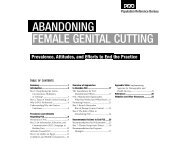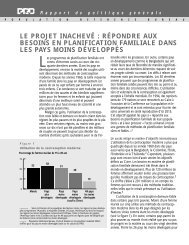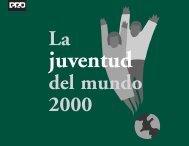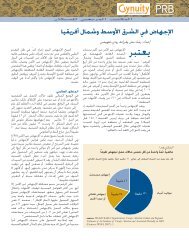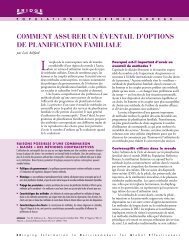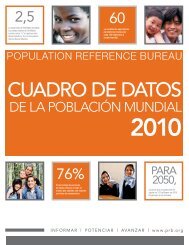Immigration Shaping America - Population Reference Bureau
Immigration Shaping America - Population Reference Bureau
Immigration Shaping America - Population Reference Bureau
You also want an ePaper? Increase the reach of your titles
YUMPU automatically turns print PDFs into web optimized ePapers that Google loves.
Figure 2<br />
<strong>Immigration</strong> to the United States, 1820 to 2001<br />
<strong>Immigration</strong><br />
phase:<br />
Frontier<br />
expansion Industrialization <strong>Immigration</strong> pause Post-1965<br />
immigration<br />
1,800<br />
Major sending<br />
regions:<br />
Northern<br />
and<br />
Western<br />
Europe<br />
Southern and<br />
Eastern Europe<br />
Western Europe<br />
Asia and<br />
Latin<br />
<strong>America</strong><br />
1,600<br />
1,400<br />
1,200<br />
IRCA<br />
legalization<br />
1,000<br />
800<br />
600<br />
400<br />
Immigrants<br />
(thousands)<br />
200<br />
Immigrants<br />
(thousands)<br />
0<br />
1820 1840 1860 1880 1900 1920 1940 1960 1980 2001<br />
Note: IRCA refers to the amnesty provisions of the <strong>Immigration</strong> Reform and Control Act of 1986, under which<br />
2.7 million unauthorized foreign residents obtained legal immigrant status.<br />
Sources: <strong>Immigration</strong> and Naturalization Service, 2001 Statistical Yearbook of the <strong>Immigration</strong> and Naturalization<br />
Service (2003): table 1.<br />
14<br />
United States expanded westward.<br />
The Louisiana Purchase of 1803<br />
made <strong>America</strong>ns out of the French<br />
residents living in that territory. Mexicans<br />
in California, New Mexico, and<br />
Texas became <strong>America</strong>ns in 1848, as<br />
a result of the Mexican War. In 1898,<br />
the United States acquired Puerto<br />
Rico in the settlement of the Spanish-<br />
<strong>America</strong>n War; Puerto Ricans became<br />
U.S. citizens in 1917.<br />
The third and largest source of<br />
<strong>America</strong>ns was immigration. In 1789,<br />
after the former British colonies<br />
had become one country, the word<br />
“immigrant” entered the language<br />
to denote a person who voluntarily<br />
moves from his or her own country<br />
to another established nation. Immigrants<br />
and their descendants, along<br />
with the colonials, the slaves, the<br />
<strong>America</strong>n Indians, and their descendants,<br />
are the <strong>America</strong>n people of<br />
today.<br />
The flow of immigrants has fluctuated<br />
with economic conditions in the<br />
United States and abroad and with<br />
U.S. immigration policies. For these<br />
reasons, the tally of annual arrivals<br />
has peaks and troughs. The four<br />
major peaks are referred to as the<br />
four major waves of immigration.<br />
First Wave: Before 1820<br />
The first wave of immigrants arrived<br />
before entries began to be recorded in<br />
1820. The English made up 60 percent<br />
of the population in 1790, but there<br />
were also Scots, Scots-Irish, Germans,<br />
and people from the Netherlands,<br />
France, and Spain. These migrants<br />
were motivated by a mixture of religious,<br />
political, and economic factors.<br />
German sectarians sought religious<br />
freedom in Pennsylvania; Spaniards<br />
looked for Christian converts in<br />
Florida and the southwest; and the<br />
Puritans in Massachusetts sought to<br />
establish a community restricted to<br />
members of their faith. Religious freedom<br />
was made possible by political<br />
and economic freedom: the absence




